2018 Projects
Design Productions
Street Photography
Preceding the Citizen Project, we were introduced to street photography in Design in order to get acclimated with the challenging task of taking photos of strangers on the street without being noticed. In order to attempt this, I used a micro lens so that I would be able to get clear shots from a distance of 20-30 ft., and tried to be incognito, which was not entirely successful. While I managed to get a few photos that I’m proud of, many people noticed when they heard the camera click and became annoyed or angry. This is why I don’t enjoy street photography very much, but it was a useful exercise in getting out of my comfort zone and exercising confidence in the face of intimidation.
The photo I selected for my Street Photography project was of a man sitting in a cafe reading, and I titled it with the feeling I interpreted from his appearance: “Focused”. I edited the colors, lighting, etc. in Photoshop, and cropped the original photo to purposefully go against the rule of thirds, centering the subject to keep in line with the feeling of focus.
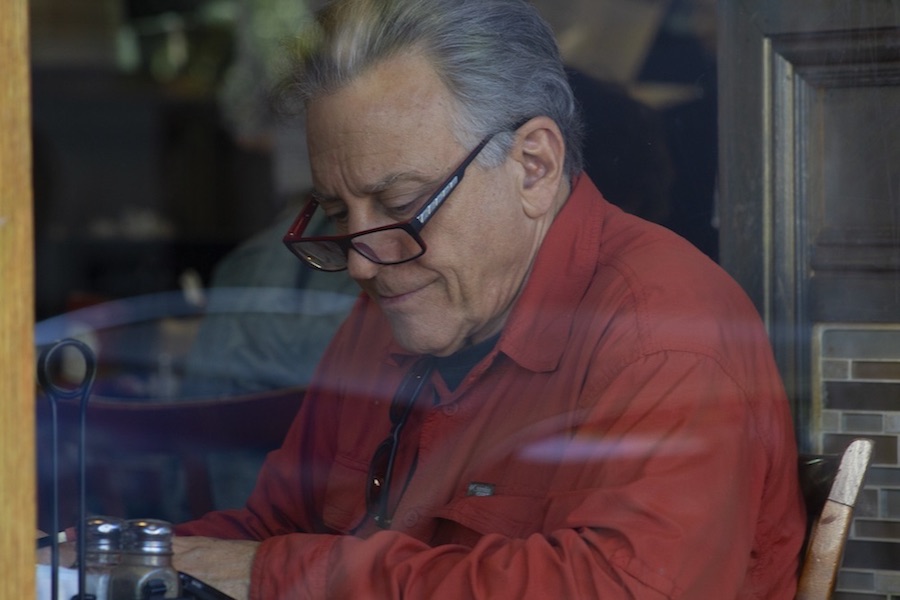
Citizen Diptych
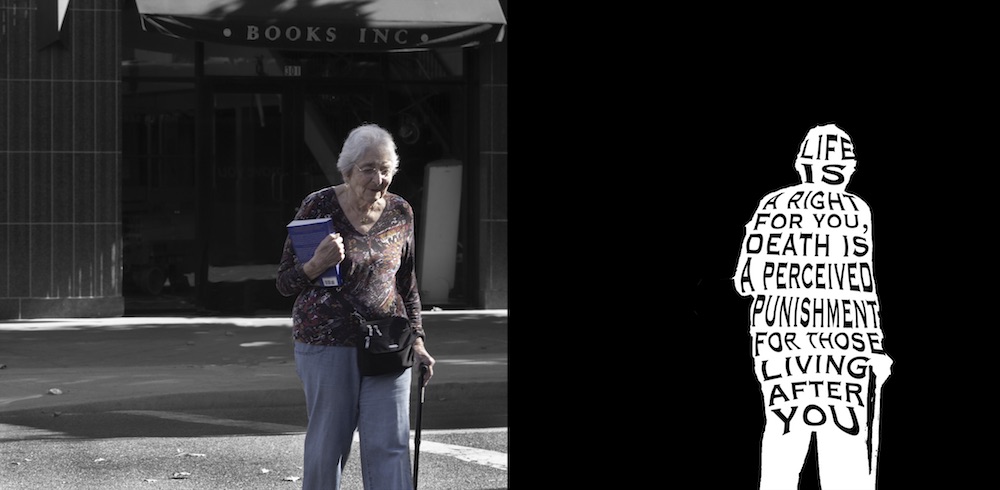
In our English class, we produced a ‘Listener Lyric Essay’ in which we chose an subject who had a controversial identity to interview and write a lyrical essay about. For my essay I chose a woman who elected to die by assisted suicide on Halloween of 2017.
The passage I chose from my Listener Lyric essay for this project was, “Life is a right for you, death is a perceived punishment for those living after you”. This passage is about the laws surrounding assisted suicide, and how outlawing it is often just prolonging suffering rather than upholding rights to life.
I chose this image to represent my written piece because it shows age and transcendence. The woman in color is an elderly woman, similar to the anonymous woman who I structured my essay around. While it is unintuitive from a photography perspective to have the subject seemingly walking out of the photo, I think that it is fitting given the subject matter because the woman who I interviewed has walked into an unknown state of being, death, which is unseen by anyone, similar to how the viewer of this photo doesn’t know what the subject is walking out of the frame toward. While the viewer doesn’t know what the subject is walking toward, she appears confident and assured of her course, much like the subject of my paper who is confident of what comes next for her because of her beliefs. Another reason I chose this photo is because the background is a vacant Books Inc., a store which (unlike most bookstores) moved location, leaving this space empty of knowledge but transferring it somewhere else, which is essentially what the subject of my paper believes happens to her mind in the quantum realm which proceeds after life on earth.
To manipulate this photo, I duplicated it in black and white and created a mask, exposing the an area of the first colored layer. I then used a white fill copy of this selection for the passage, using a font similar to the Books Inc. logo for symmetry.
Japanese Stab Binding Book
In Design, I fully produced a Japanese Stab Binding book which was in conversation with the Citizen project we did in English. The Japanese book contains five sections, each with four pages. I chose five letters of ‘Kanji’, Japanese words, which relate to the theme of my essay. Then I took photos with a macro lens of several plants and flowers, which I manipulated in Photoshop to make them appear like watercolor paintings. The next page is printed quotes from my essay, overlaid on transparent paper above my own paintings done in Black India Ink on paper I created by dying ripped pieces of Japanese newspaper in tea and glueing together on rice paper. The cover was created by pasting decorative paper on book board, and I chose a green and pink Springtime color scheme. I wrapped a frame made of book board for the front cover, and strung beads inside the frame for visual interest. After I had every section of the book completed, I clamped it between tow clips and drilled the holes with a drill press. Then I used wax coated twine and a needle to bind the book in a traditional pattern.
I really enjoyed this project and learned a lot from it, from Photoshop manipulation to Japanese art styles. The best part of this project was being able to look through my completed book and appreciate the fact that I had made the entire thing by hand, and it’s a project I would like to repeat on my own in the future.
Movie Premiere Package
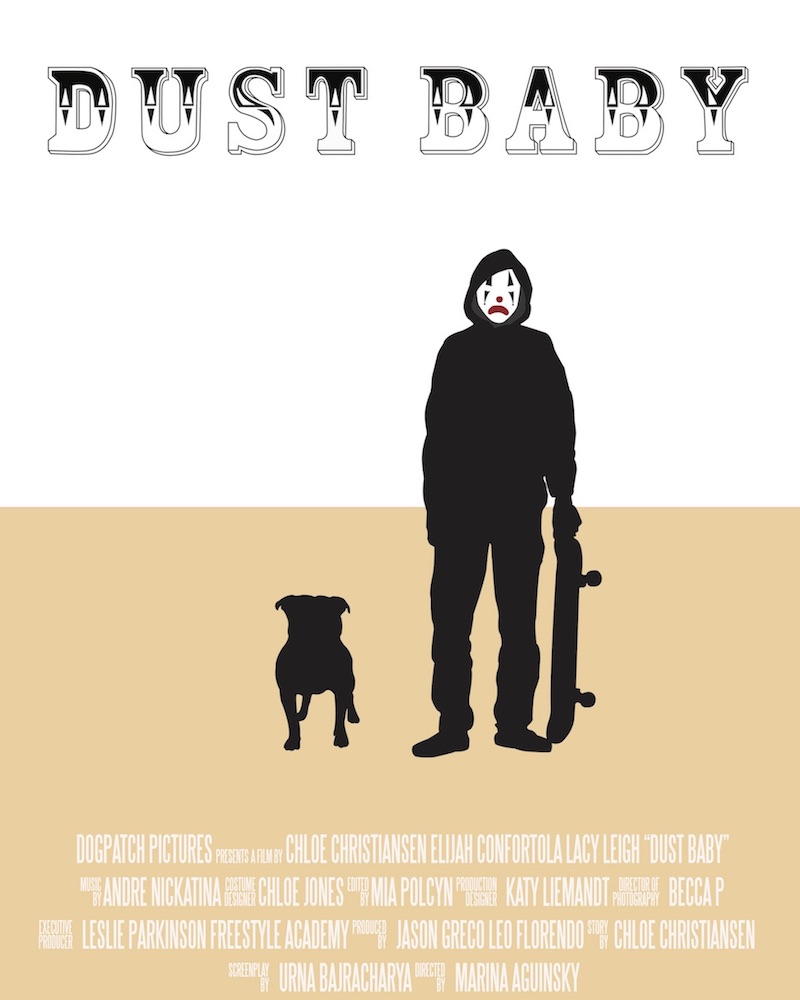
For this project, we chose a conceptual movie idea to create a movie premier package for. In my film, I live in a community of nihilistic skateboarders in palm desert, dressing as clowns and skating around breaking glass and stealing Red Bull from 7 Eleven.The community ignores us, giving us total freedom but making our lives devoid of meaning or morality. When we find a barrel of puppies, we begin to discover a nurturing instinct and a purpose as we raise the dogs. Each of the puppies claims a person and teaches everyone about love and loyalty.
In the cover scene, a man working at one of the windmill farms found my puppy Claus trespassing. He was trying to shoot him, so I swooped in on my skateboard to save Claus and the cover shows us escaping down the empty desert highway. Claus is running next to me while I skateboard, and there is nothing in the surrounding land. The image on the cover is in a moment of calm after escaping the windmill man, and we are facing the camera head-on.
The posters are in a minimalist style, so we were able to choose two colors to use. I decided on a light beige, to represent the desert, and a deep red for the clown features. I then used black and white for the other details. I designed my own font, and wanted it to be in the style of western mixed with carnival. I included triangles to match the face paint on the clown, and had it at the top above the horizon. The poster was designed in Adobe Illustrator with original drawing and font. I then created a corresponding movie premiere ticket, in the shape of a skateboard, and a custom envelope to display the tickets. The tickets were designed in Adobe Illustrator and the folded envelope was designed in Adobe InDesign.

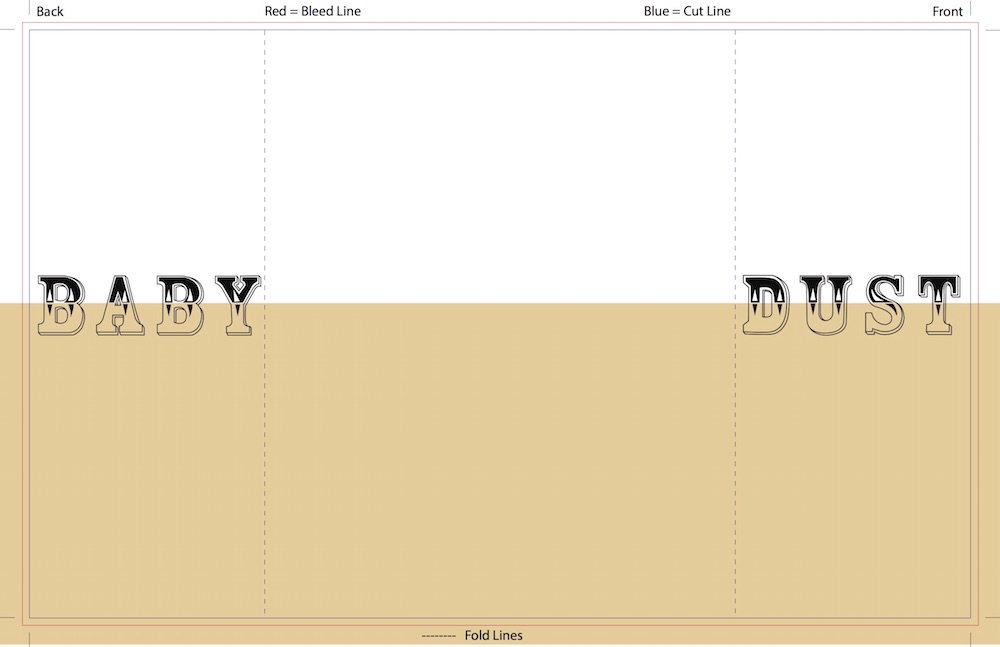
Digital Collage
As a continuation of the collage project we did in the beginning of the 2018 school year (shown on ‘Reflections’ page), we created digital collages cutting together random but purposefully selected images from Google to paint an absurd landscape. I wanted my collage to make sense in an absurdist way, by combing things that don’t go together and resizing them in order to have a flow and a communication between the images. This short project was fun and silly, and I got to expand my Photoshop skills, especially with warping and adjusting the proportions of photos, while also exercising my own artistic license in drawing from the creative abyss of Google Images.
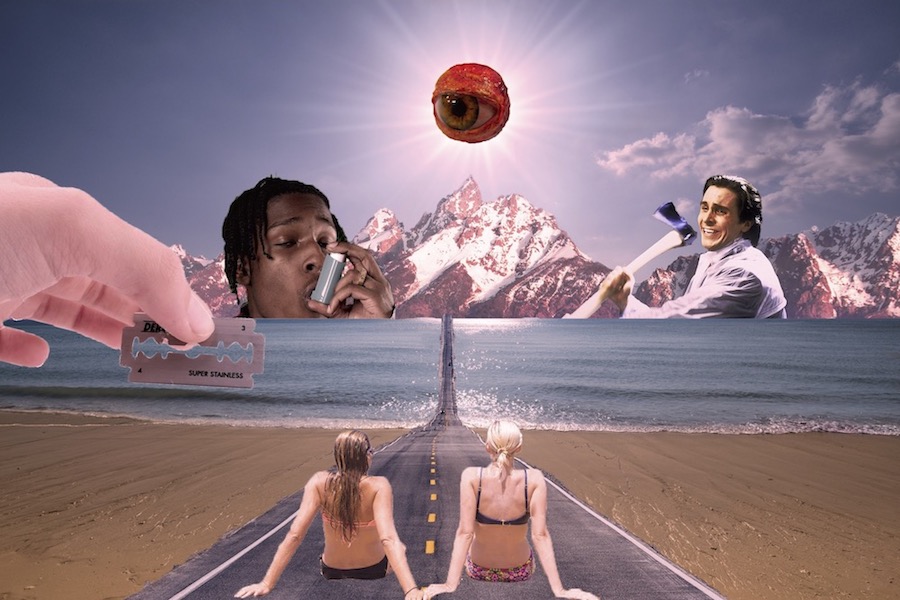
English
Lyrical Essay
“When the party has ended, the house is littered with detritus, the remnants of a good time. There is scarred wood panelling, the doorframe marking off all that youthful growth in inches per year. Everything perfectly imperfect, full of memories but lacking fresh air, lacking movement. “I’m on my way out of here,” she announces, but everyone else is focused on cleaning up, picking up cup by cup like single grains of sand, ignoring the peaceful sunlight and fresh breeze that is blocked by windows that can only be seen through by her. The house belongs to her, but she knows that she is really only visiting. This is when it is time to move on. The bedraggled partygoers tell her that she’s not allowed to, and to suffer through the discomfort as the roof slowly caves in.
End-of-life medicine.
The panacea. What is a life over-lived? She says, “The purpose of life is to be as alive as you can while you can”. The government invites itself into her body, and demands her complacency in surviving containment. She calls out, “My lease is up! Let me out of here”, for detachment is freedom, is happiness.
The body aches, and the soul demands exit from the brain. Life is a right for you, death is a perceived punishment to the living after you. A culture obsessed with death but detecting no beauty within it, no better meaning. Belief comes naturally. It may be called religion, for her they called it crazy. There are medications for crazy, but they don’t change her beliefs. What she knows to be undoubtedly true, has known all her life, is that this life is a transient state, the molecules packed closer together in the furniture and the skin than in the life before and the life after life, where all that remains is energy. As the cells rebel against the body, the energy longs to be free.
“I’m going to another dimension where I have been, always been, since before I came here, I’m going back there. I had this little interlude, it’s been fun, the party’s over, I wanna leave before the party’s fully over”.
Family, politicians, friends lay claim over the body of another. The right to death hotly debated. Is life better than death, than afterlife? The question goes unanswered. When we have questions unanswered we tend to demand control, making up answers, fudging the history. To her it is not unknown, it goes beyond words and memory, and the knowledge lives in the body. It has hidden there, pulling the mouth closed–
until now.
October 31.
The celebration of fear and death. It’s America’s infatuation, our fear, our news, our obsession. She does not fear it. She knows it, has studied it, has prepared for it. And today is the day. There are right ways to go and wrong ways to go. The government robs the lives of thousands but denies the possession of one’s own. Things begin to change, and she has claimed her time. Her energy is released into the universe, spreading consciousness.”

Social and Civic Responsibility Research Paper
For my research paper, I decided to investigate the impact of pornography on adolescent boys. This topic will tie into my Zenith project, which will be a line of artistic clothing pieces.
Here is a sample of my essay:
“There was an erotic statue in 5200 BCE (Stuttgart), explicit literature in 1557, nude portraiture in 1865, and the first hardcore pornographic film in 1908 (Head). In 2019, virtually every imaginable sexual scenario is available for viewing to anyone. The depiction of intercourse may not be avant-garde, but both the manner and scale of its production and consumption have changed drastically in less than 50 years. The porn industry has an estimated net worth of $97 billion (“How Big is the Porn Industry?”), and accounts for 30% of all data transferred across the internet (Kleinman). Safe to say: people watch a lot of porn.
The unprecedented magnitude of this industry poses ramifications which may be farther ranging than expected or understood. Whether intended or not, an industry of this magnitude which appeals to society so primally will be mimicked by the culture it thrives in. These ramifications (both positive and negative) have the greatest effect on developing brains, and the disparity of gender roles which are performed in porn have potentially destructive effects on adolescent boys. Similarly to anti-video game game advocates, anti-porn advocates may exaggerate the correlation between active violence and consumption of pornography – however, we may see the misogynistically violent tropes played out in porn as reflections of our society’s actions and beliefs, and it is important that young men are armed with the mental tools needed to draw a line between performed fantasy and real- life morality. The perpetuating ideation of male stereotypes which are harshly enforced on boys from birth to adulthood serve to implement more harm than good, and aim to suppress ‘feminine’ traits which are integral to positive mental health. Strong-man caricatures prominent in heterosexual pornography who dominate and conquer their apparent ‘victim’ do not paint a realistic picture of human intimacy and do not make positive role models for impressionable boys. With American pornography being easily accessible to children and teenagers, the largely violent overtones prevalent in explicit content have the ability to negatively shape boys’ views of relationships, women, and themselves.”
Honors Memoir Essay
For Honors English, I read a memoir entitled Hillbilly Elegy which was written in 2016 by JD Vance, a man who grew up in poverty in white Appalachia. The goal of this essay was to analyze the writing and memoir content in order to learn more about how to write about myself and my experiences.
“Hillbilly Elegy chronicles the life and history of author J.D. Vance. In this retrospective analysis, Vance sets out to delineate the causal factors of the problems that are largely afflicting the low-income, conservative, white middle America which is at the forefront of an increasingly volatile political climate. He does this by examining his own childhood and family history which are wrought with trauma. Vance grew up in the small towns of Jackson, Kentucky, and Middletown, Ohio. These areas are turning out high proportions of drug addicts, school dropouts, underage parents, and domestic abusers. Vance was subject to all of these problems while growing up, yet he managed to come out on top (by exterior metrics of success), and he even managed to overcome a lot of inner strife in order to be a happily married father of two. Vance challenges many misconceptions about Appalachian hill people (hillbillies) using his first-hand experience, bringing to light the core patterns of thought and action which have run his hometown community into the ground. The significant upward mobility which Vance managed to achieve was possible due to his development of the values of loyalty, stability, and generosity, which he lacked during his childhood, developed during adolescence and early adulthood, and gives back to his community now.
The challenges Vance faced while growing up were diverse and constant. After being given up by his father around age five, his unstable mother had solo custody of him and his older sister, Lindsay. Vance’s mom succumbed to the statistical expectations of growing up in an unstable home (her father was a violent alcoholic) and exhibited almost every issue prevalent within their community. She was an opioid addict, had children by multiple men, switched partners and homes consistently while Vance was young, did not get a college education, was arrested multiple times, and was both verbally and physically abusive to Vance throughout his time in her custody. Vance explains of his life under one of many father figures, “Even when the house was ostensibly peaceful, our lives were so charged that I was constantly on guard…. Though I didn’t realize it at the time, the trauma at home was clearly affecting my health” (72). This period began the degradation of Vance’s resilience and performance. His grades fell, he began to experiment with drugs, and he became increasingly contemptuous.
The one source of structure, however, that remained in Vance’s life through all of his adverse childhood experiences was his grandmother, nicknamed Mamaw. A fiery and intelligent woman, she instilled in him a love of learning and hope for a better future. Part of Mamaw’s drive came from a fierce loyalty to family, a value which she instilled in Vance from an early age. Vance writes of an incident following his mother’s marriage to a father of two named Ken, explaining; “The oldest boy fought constantly with Mom…. One night, I came downstairs just as he called her a bitch. No self-respecting hillbilly could stand idly by, so I made it abundantly clear that I meant to beat my new stepbrother to within an inch of his life…. I wasn’t even particularly angry. My desire to fight arose more out of a sense of duty” (126). Vance recognizes this ideology within himself as an attribute at times, however he also blames it as a source of problems in the hillbilly population. Because of this strong loyalty, there is denial and secrecy surrounding many problems within hillbilly families as they defend each other from criticism of any kind. This enables individuals to ignore their own contributions to communal downfall and fosters a victim mentality. The Vance family’s loyalty was misplaced during his childhood– it enabled his troubled mother to continue a cycle of drug addiction and abuse without accepting consequences. Vance’s turbulent childhood placed him in a constant state of emotional instability, and it was only thanks to Mamaw and other sources of structure in his life that he was able to progress.
As Vance moved out of adolescence, he began the path of upward mobility. This began with his moving into Mamaw’s house permanently. Without the instability imposed by his unintentionally nomadic mother, his life began to improve. Vance’s grades went up, his substance abuse went down, and without noticing it, he started to feel happier. Mamaw’s value of education and insistence that Vance could achieve great things through hard work were ingrained upon him. Vance recalls, “I always straddled those two worlds. Thanks to Mamaw, I never saw only the worst of what our community offered, and I believe that saved me. There was always a safe place and a loving embrace if ever I needed it. Our neighbors’ kids couldn’t say the same” (149). The two worlds which Vance refers to were the loving and stable home which he sometimes got to experience with Mamaw, in contrast to the tempest of addiction and instability with his mother. Because Vance had somewhere to go when things got really bad, he knew there was hope for a future of healthy relationships, financial comfort, and stability. The decision that Vance made which he considers pivotal in changing his own outcome was when he decided after high school to join the Marines. At this point he felt ambivalent about college, physically unhealthy, repressing trauma, and had very little understanding of the working world. He knew that he could not easily afford higher education, and didn’t feel ready to take on the challenge of advanced schoolwork. Upon entering the Marines he was given immediate and rigorous structure: something he had never experienced. He was forced to follow a schedule, push his body to the limits with exercise, leave his hometown, and get to know people from all walks of life.”
Honors Biss/Rankine Response
Another project which I did in Honors English was to compare the works of authors Eula Biss and Claudia Rankine who were writing about racial identity in America. We had several discussions as we moved through their books, and then wrote a response comparing two specific pieces from each of them:
“Biss: Page 154-155
“One evening not long…. but is in fact always open.”
Rankine: Page 18-19
This passage from No Man’s Land describes an incident Biss experienced while living in Chicago, when two African American boys rode past her and her husband on bikes as they were entering their home, calling out, “Don’t be afraid of us!”. Biss makes eye contact with one of the boys, but does not respond out of discomfort and fear of provocation. At the end of this passage, Biss notes that the gate to their house, a threatening iron gate, appears locked “but is in fact always open”, which could be a metaphor for the artificiality of ‘safety’ and how the illusion of being protected from strangers actually serves as more of a cage. The connecting piece I chose from Citizen is the passage describing ‘you’, the protagonist, going to a new therapist for trauma counselling, knocking on her door, and being confronted with bitter anger and hatred because of ‘your’ appearance. This passage is accompanied by the art piece depicting a human face sewn onto the body of a deer, the picture of helplessness and innocence. These two pieces rely upon the theme of fear, and the many ways in which it is fabricated into our ideas of race and identity. As Biss brings to thought throughout her book, fear based solely on race is baseless and violent, and this violence is not felt only by African Americans but by everyone who is subjugated by collective irrational caution. Rankine allows the reader to have a visceral view into the experience of the African American who is confronted with this violent fear in this passage. The white woman yells, “Get away from my house! What are you doing in my yard?”, and we see the wounded face of the deer-human staring up at the text, painfully visible against an empty white background. Rankine compares the angry white woman to ‘a wounded Doberman Pinscher’, reminding us that there is no benefit in this violent fear to either party. Pain is inflicted on both sides, but while one is in fear of their life, perhaps remembering the trauma that led them to therapy, the other is suddenly confused, apologizing. She doesn’t know where her fear came from, it is simply buried within her like a thorn in the side of a dog. In Biss’ account, despite her position of racial privilege we see her as the deer and not the Doberman. She has suddenly been confronted with others’ expectation of her perception, and feels powerless to challenge it. In this situation, the power dynamic becomes hazy, and it is clear the there is no benefitter from fear. While Biss recognizes that stereotypes are self-fulfilling, and do not speak to character comprehensively, she notices the 40 oz. bottles, and swerving bikes, and she is afraid to come off as threatening. Because of this, the boys continue down the street, and while nothing bad has happened, no progress has been made, and a momentary connection has been lost to fear.”